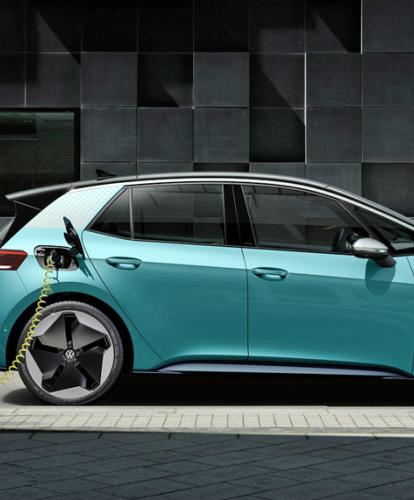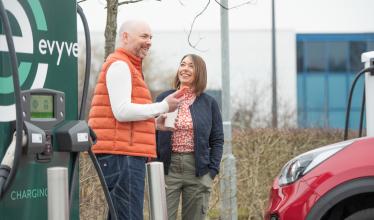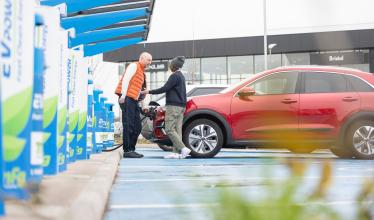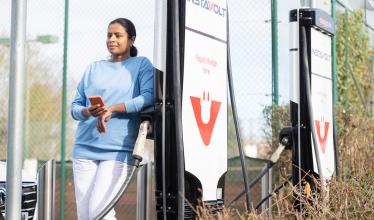With electric vehicles and EV chargers becoming increasingly common on UK roads, what can we expect to see in the coming 12 months? Zapmap takes a look at the key trends set to be introduced and gain popularity in 2020. Our expectations are that the EV features we cover in this article will become commonplace by the end of the year.
Faster charging everywhere

Last year we predicted that while more high-power charge points would be rolled out across the UK, it would be early days for ultra-rapid (>100 kW) charging infrastructure (other than Tesla Superchargers). This has proven to be the case as, while a number of 100 KW, 150 kW, and 350 kW devices open to all EV users have been installed, of the 400 operational ultra-rapid devices, only around 55 are non-Tesla units.
That said, ultra-rapid coverage beyond Tesla’s network is set to expand quickly. A number of networks are currently installing ultra-rapid charge points across the UK, with the likes of Polar and InstaVolt having committed to rolling out these high-speed units in significant numbers. Other key players include Ionity – an ultra-rapid-only network – which is installing points along key routes across the UK and Europe. Ionity already has a handful of chargers live, and is set to ramp up works to provide more.
The increase in the number of ultra-rapid chargers is important as EVs with larger batteries are starting to become available. A few years ago, it took around 20 minutes on average to recharge a typical EV (with a 120 mile range) on a 50 kW rapid unit. It now takes at least twice that time, as average battery capacities (and ranges) have almost doubled. Some premium models such as those available from Jaguar, Audi, and Tesla have batteries around 90 kWh, which can take an hour and a half to recharge on a 50 kW rapid point. By boosting the charger to 150+ kW, recharging times can be returned to under 30 minutes.
Going ‘ultra-rapid’ also future-proofs the UK’s charging infrastructure. Although no EVs can yet charge at 350 kW, the Porsche Taycan will become available in 2020 with charging capabilities approaching 300 kW, minimising charging times for the long-distance EV. Other manufacturers are intending to follow Porsche’s lead and launch EVs with ultra-rapid charging capabilities. By design, most of the ultra-rapids being installed now are upgradeable from 100-150 kW to 350 kW, which is close to the theoretical maximum power of 400 kW.
From stations to hubs

EV charging hubs are popping up across the UK, and will certainly become a key trend in 2020. The move from installing one or two charge points at a site to a cluster of units is important as EVs become increasingly mainstream. Where it was once fine to have a single rapid charger at a location because there were few drivers capable of using them, greater numbers of EVs on the road means this is no longer sufficient. Even Tesla Model 3 drivers are having to queue at Supercharger locations at peak times due to an insufficient number of chargers.
As such, charging hubs are being planned at important sites, mimicking petrol stations in offering a large number of units from which to charge. Over and above conventional fuelling stations, facilities such as a good quality cafe, quiet work spaces, rest areas and selected retails outlets are also being planned for some of the major hubs; a recognition of what EV drivers want and need while their cars are on charge. 2020 will see the emergence of new brands such as Gridserve appear on key UK routes in the race to roll out quality charging facilities which meet the needs of 21st century drivers.
While the term ‘charging hub’ is currently used quite flexibly, at Zapmap we are developing a few ground-rules about what constitutes a real ‘hub’ as opposed to a station with several devices. We think that to be categorised as a ‘hub’, a site must have at least six high-quality rapid devices, with significant on-site facilities such as refreshments, work-spaces, toilets, and/or a waiting area. Look out for our new ‘hub’ category which will appear on all Zapmap filters early in 2020.
The rise of plug, tap, and go

Easier access to all EV charge points – whatever their network – has been a key demand from EV drivers for some time now, and the introduction of contactless enabled chargers – now available on around 25% of rapid devices – is starting to deliver on this issue. Being able to park at a charger, and tap a debit or credit card to pay for your charge – as you would at a petrol station or supermarket – is an obvious solution to the demand for open and easy access. Contactless means there’s no need for the network-specific RFID cards, the right app on your phone, or even signal to make sure that app works. The simplicity of paying using a bank card is perfect, particularly for occasional use.
It is still the case that joining a network can provide a number of member benefits. Subscription services do mean that account details are already sorted, and can often reduce the cost of charging compared to contactless-enabled points. However, many EV drivers are willing to pay a little more per kWh for the convenience of accessing a rapid charge point which they wouldn’t normally use – one that’s along a long trip for example. With contactless being mandated on all new rapids from April, we confidently predict that contactless will become the ubiquitous solution for most rapids by the end of 2020 and beyond.
However, contactless can’t be the only solution as, due to the hardware costs, the tech won’t find its way on to the majority of non-rapid or legacy units. It also fails to give EV drivers all the information they need, particularly when charging, as there is no digital connection between the charging networks and the driver, so services such as live session updates to a driver’s phone can’t be provided. This is where our solution, called Zap-Pay, fits the bill, that utilises the contactless experience where possible or non-contactless where not, and which enables all Zapmap users to access charging on participating networks. Look out for the first Zap-Pay accessible networks in early 2020.
More advanced still are systems which automatically connect and initiate payment and charging session. Park up, plug in the car, and the EV and charge point will pass information back and forth to confirm and start the charge. Once finished, the costs are then calculated and billed to an account associated with the car. Of course, Tesla drivers will tell you that this is nothing new as this is how the Supercharger network has been operated for years. True, but 2020 will see other manufacturers adopting the technology in partnership up with the major networks. Intentions for plug-and-go charging have been announced by many of Ionity’s backers which include Audi, BMW, Mercedes, Ford, Hyundai, Kia, and Volkswagen.
The bigger picture

With a combined multi-megawatt-hour battery capacity, EVs will increasingly play a key role in national energy supply and management, particularly in delivering the large amounts of renewable energy required to combat climate change. Smart EV charge points are already required at all new home chargers as part of OLEV funding rules, and it certainly makes sense to help balance the load on the grid. If chargers can top-up EVs at off-peak times, it allows for cheaper prices and improved efficiency of the UK’s electricity infrastructure. Vehicle-to-grid (V2G) charging will also be part of the solution, and is expected to be launched in earnest during 2020.
Given their high energy and customer throughput, charging hubs will also have a key role to play in providing this critical energy service, acting as energy storage systems to soak up excess renewable energy at off-peak times, and then boosting the grid during peak demand. As we have already highlighted, plans are already underway for large scale charging hubs – with 20 or more charging devices – that use energy storage solutions alongside renewable electricity generation to supply both the ultra-rapid EV charging requirement and help the national energy grid. These hubs will start to appear during 2020 to support the increasing amount of renewables coming online.
Although precisely when these technologies appear on UK roads is uncertain, at Zapmap we are highly confident that 2020 will prove a turning point for the EV sector in general and charging networks in particular. With dozens of new EV models set to launch throughout 2020, and the popularity of EVs as conventional cars continuing to accelerate, the good news is that charging infrastructure looks to be keeping pace with investment and innovation. History is very likely to look back at 2020 as the year when the EV and EV charging went mainstream – and hopefully just in time to make significant reduction in transport’s impact on climate change and air quality.
Here’s to an electric 2020 and wishing you a Happy New Year from the Zapmap team!



